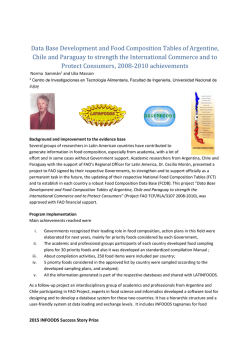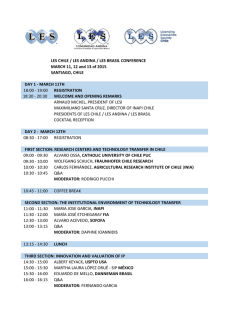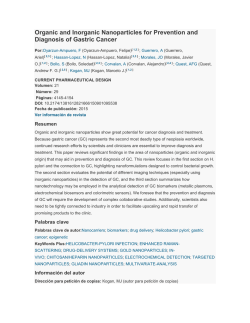
F%F3siles en archipi..
Revista geológica de Chile versión impresa ISSN 0716-0208 Rev. geol. Chile v.25 n.2 Santiago dic. 1998 doi: 10.4067/S0716-02081998000200004 Discovery of Late Triassic fossils in the Chonos Metamorphic Complex, Southern Chile Zong-jie Fang Nanjing Institute of Geology and Palaeontology, Academia Sinica, Chi-Ming-Ssu, Nanjing 210008, People's Republic of China, Arthur Boucot Department of Zoology, Oregon State University, 3029 Cordley Hall, Corvallis, Oregon, U.S.A. Vladimir Covacevich Francisco Hervé Servicio Nacional de Geología y Minería, Avda. Sta. María 0104, Casilla 10465, Santiago, Chile Departamento de Geología, Universidad de Chile, Casilla 13518, Correo 21, Santiago, Chile e-mail: [email protected] ABSTRACT The late Triassic bivalve Monotis (Pacimonotis) aff. subcircularis Gabb indicative of a Norian (probably early late Norian) age has been collected from the southeastern end of Patranca Island (45º25'S-74º09'W) in the Chonos Archipelago, Southern Chile. Another fossil bivalve, Limidae gen. et sp. indet. has been collected from a small unnamed island (45º25'S-74º10'W) 4 km to the north, and indicates a maximum Early Carboniferous, probably Mesozoic age. The fossil bearing unit is the Potranca Formation (or Potranca Unit) which forms part of the Chonos Metamorphic Complex, interpreted as a subduction complex developed on the southwestern margin of Gondwanaland. As these rocks have been previously considered to be of Paleozoic age (Late Silurian-Early Devonian), the geologic history of this part of the continental margin must be reinterpreted. These fossils provide clear evidence that marine depositional processes persisted within the Chonos Metamorphic Complex during Late Triassic time. Key words: Palaeontology, Fossils, Triassic, Chonos Metamorphic Complex, Chile. RESUMEN Hallazgo de fósiles del Triásico tardío en el Complejo Metamórfico de los Chonos, sur de Chile. Se identificó la presencia del bivalvo Monotis (Pacimonotis) aff. subcircularis Gabb, que indica una edad nórica (probablemente Nórico superiortemprano) en rocas provenientes del extremo suroriental de la isla Patranca (45º25'S-74º09'W) en el Archipiélago de los Chonos, Aisén. Otro bivalvo fósil, Limidae gen. et sp. indet. fue recolectado en una pequeña isla sin nombre perteneciente al Grupo Smith (45º25'S-74º10'W) ubicada ca. 4 km al norte de la anterior, que indica una edad máxima carbonífera inferior, probablemente mesozoica. La unidad fosilífera es la Formación Potranca (o Unidad Potranca), integrante del Complejo Metamórfico de los Chonos, que se ha interpretado como un complejo de subducción formado en el margen suroccidental del continente de Gondwana. Dado que estas rocas han sido habitualmente consideradas como paleozoicas (Silúrico superior-Devónico inferior), es necesario reinterpretar la evolución geológica de esta parte del margen continental. Estos fósiles proveen clara evidencia que los procesos de sedimentación marina persistieron en el Complejo Metamórfico de los Chonos durante el Triásico Superior. Palabras claves : Paleontología, Fósiles, Triásico, Complejo Metamórfico de los Chonos, Chile. INTRODUCTION Large tracts of the Coast Ranges of Chile south of 34ºS are underlain by igneous and metamorphic complexes. These rocks were represented as Precambrian in the geological map of South America (Harrington, 1962). However, radiometric dating of the complexes at different latitudes (in Hervé, 1988) has failed to yield ages older than Carboniferous; these ages are interpreted broadly as the age of metamorphism of the complexes. Paleontological information about the age of deposition of these complexes is very scanty. Tavera (1979) describes the presence of Gordia sp.? and Crossopodia nahuelbutanus at Lumaco (39ºS) which he interpreted as indicating Silurian deposition. At Buill (42ºS), Biese (1953) found trilobites not in situ mentioned as a 'Calymenidae von devonischen Habitus'. Pérez in Levi et al. (1966) and later Fortey et al. (1992) identified Devonian deposition, based on the presence of Calmoniidae trilobites. Tavera in Cecioni (1955) reported the presence of fusulinids in several localities in the islands of the Archipelago Madre de Dios (50-51ºS) assigning the host limestones to the Permo-Carboniferous. Later, Douglas and Nestell (1976) describes a fusulinid assemblage in the same area, indicative of Late Pennsylvanian and Early Permian age. Ling and Forsythe (1987) reported the presence of Late Carboniferous to Permian radiolaria in cherts from Madre de Dios Archipelago, and from Regalada Island (54ºS). These localities are indicated in text figure 1a. FIG. texto 1. a- location map of the Chonos Metamorphic Complex, in the frame of the 'basement rocks' of Southern Chile (modified from Hervé, 1988). Fossiliferous localities in this 'basement' indicated; b- geologic map of the Smith group of islands within the Chonos Archipelago (modified from Hormazábal, 1991), with indication of the fossil bearing localities discussed in this paper. In the Chonos Archipelago, Miller and Sprechmann (1978) describes what they identified as Early to Middle Devonian brachiopods (Scaphiocoelia? sp.; Early Devonian Derbyina whitiorum Clarke and Schuchertella sp.) from Patranca Island1, Smith Group (text-Fig. 1b). In later publications on this area by many authors, this was considered to be the age of deposition of the Chonos Metamorphic Complex, even though Fuenzalida and Spring (1979) mentioned that fossils from the same locality on Patranca island as those of Miller and Sprechmann's (1978) had been identified by the late Professor J. Tavera as Pseudomonotis ochotica (Keyserling) (=Monotis (Entomonotis) ochotica (Keyserling)) indicating a Late Triassic age. As this publication did not give any details on the fossils studied, this information has not been fully considered by later authors working in the area. In recent years, one of the authors (FH) has been conducting a study of the petrologic characteristics of the Chonos Metamorphic Complex, and had the occasion to collect fossils from the same localities on Patranca Island and the small unnamed island as those of Miller and Sprechmann's (1978) and Fuenzalida and Spring (1979). The collected material was first examined by one of the authors (AB), who considered that the fossils were not brachiopods, and that they are probably bivalves and younger than Devonian. He also noted that Miller and Sprechmann's (1978) identification of Eocoelia? Of Early Silurian age, a strictly Northern Hemisphere genus (Llandovery-Early Wenlockian) together with typical Malvinokaffric Realm Early Devonian (Siegenian-Emsian) possibly later Devonian genera was extremely unlikely. As a result, the fossils were sent to Professor Zongjie Fang who produced the results presents below. These results confirm Tavera's opinion on the geological age (inFuenzalida and Spring, 1979). The authors doubt the correctness of Miller and Sprechmann's (1978) brachiopod identifications and suspect them to be the same bivalves present in the author's collections. However, the authors are unsure of this supposition until their fossil material is restudied. The purpose of this paper is to present the results of the paleontological study of the fossil samples collected on Patranca Island and on the unnamed island, with a discussion of the geological framework of the area and the implications of the new age determination. GEOLOGICAL FRAMEWORK The Potranca Formation (Miller and Sprechmann, 1978) later referred to, as the Potranca Unit (Davidson et al.) is part of the Chonos Metamorphic Complex. It is composed of submarine fan turbidites and subordinate pelagic cherts, both of which contain well preserved primary sedimentary structures. Bands of sheared sandstone, mudstone and conglomerate (broken formations) are locally developed. The Smith Group of islands, where both fossil localities are situated, is underlain by a turbidite sequence, with coarse to fine-grained sandstone in beds from decimeter to 10 m thicknesses, commonly with rip up pelitic clasts. The interbedded pelites have well-developed cleavage. Illite crystalinity studies (Hormazábal, 1991), indicate anchimetamorphic grade. To the west, the turbidite sequence is replaced by strongly foliated and recrystallized micaschists and greenschists. Miller (1979) suggested that the Potranca Formation unconformably overlies the schists. Davidsonet al. (1987), contrarily, suggested that the schists are the result of progressive westward increase in strain and metamorphism of the Potranca Formation (Potranca Unit) rocks. The Chonos Metamorphic Complex is interpreted as a subduction complex accreted to the ancestral Pacific margin of Gondwanaland. Its metamorphism and deformation must have occurred before the intrusion of the North Patagonian Batholith, which intrudes the already deformed and metamorphosed rocks of the complex. The older ages of the North Patagonian Batholith in the Chonos Archipelago are Early Cretaceous (Pankhurst and Hervé, 1994). SYSTEMATIC PALEONTOLOGY Class Bivalvia Linné, 1758 Subclass Pteriomorphia Beurlen, 1944 Order Pectinoida Rafinesque, 1815 Superfamily Monotoidea Fischer, 1887 Family Monotidae Fischer, 1887 Genus Monotis Bronn, 1830 Subgenus Pacimonotis Grant-Mackie and Silbering, 1990 Type species (by original designation): Monotis subcírcularis Gabb, 1864 Monotis (Pacimonotis) aff. Subcircularis Gabb, 1864. Plate 1, Figs. 1, 2. Compare: Monotis subcircularis, Westermann, 1962, p. 781, p. 115, Figs. 69; Monotis (Entomonotis) subcircularis, Grant-Mackie, 1978b, p. 489, Figs. 15-25, 28-43; Beltan et al., 1987, p. 103, Figs. 2, 3. Material: more than twenty fragmental specimens. Two of them, are almost complete, but have been secondarily deformed. Description: shell medium-sized, originally probably subequivalve and obliquely subcircular, posterior ear weil differentiated from body of shell by auricular sulcus; slightly concave, nearly smooth; surface marked with intercalated radial plicae of three orders, similar on both valves, twenty to thirty in total, more or less wavy rather than straight; primaries strong, narrow, high, well differentiated from interspaces, slightly weakened posterodorsally; secondaries starting from above half of shell height, significantly weaker than primaries, tertiaries very weak, appearing near ventral margin; concentric lamellae beyond recognition. Remarks: the specimens are poorly preserved. Here, they are assigned to Monotis (Pacimonotis) judging from the general outline and the intercalated radial plicae, which slightly weaken posterodorsally. The visible characters of the present specimens (such as size, inflation, smooth posterior ear, and strong, narrow plicae) coincide with M. (Pacimonotis) subcircularis Gabb. It is reasonable to compare the present form with M. (Pacimonotis) subcircularis Gabb. As yet, the characters of the anterior ears and posterodorsal margins of both valves are not known. This prevents them from making a definite specific identification. Measurements (mm) All figures are approximate because none of the specimens is quite complete. L H Left valve (Plate 1, Fig. 1) 38 33 Right valve (Plate 1, Fig. 2) 24 17 L= length; H= height Occurrence: Patranca Island, the Chonos Archipelago, Southern Chile; Potranca Formation of the Chonos Metamorphic Complex; Norian, Late Triassic (probably early late Norian). Field collection number F09605. Repository number SNGM 93789381 (Museo Geológico del Servicio Nacional de Geología y Minería, Tiltil No. 1993, Ñuñoa, Santiago, Chile). Order Limoida Rafinesque, 1815 Superfamily Limoidea Rafinesque, 1815 Family Limidae Rafinesque, 1815 Limidae gen. et sp. indet. Plate 1, Figs. 3-5 Material: a nearly complete, but strongly deformed right valve (length 35 mm, height 35 mm), and an incomplete right external mold. Description: shell medium-sized, obliquely subovate shell highly inflated, ophisthocline with anteroventral extension; hinge margin short and straight, umbo inflated, salient above hinge line, subcentral, no anterior or posterior umbonal ridge; surface covered by closely spaced radiating ribs of three orders, strong and straight, rounded, increasing by bifurcation, about 36 in number near the ventral margin, obsolete towards the anterior; no concentric ornament observed. Remarks: the present form looks somewhat similar to Monotis, especially to M. (Maorimonotis) routhieri avias (Grant-Mackie, 1978a, Figs. 8, 9; 1978b, Figs. 3-13), but without the juvenile growth-pause. The available material is too poorly preserved to indicate affinity. For the moment, it is tentatively placed in the family Limidae because of its strong anteroventral extension with rather short hinge margin, subcentral umbo and bifurcated radials. The family Limidae makes its appearance in the Early Carboniferous and persists to the present. Therefore, this rules out the possibility of the Potranca Formation being preCarboniferous in age on the unnamed island, Smith Group, the Chonos Archipelago. Occurrence: unnamed island belonging to the Smith Group, the Chonos Archipelago, Southern Chile; Potranca Formation of the Chonos Metamorphic Complex; Triassic?. Field collection number F09609. Repository number SNGM 9382-9383 (Museo Geológico del Servicio Nacional de Geología y Minería, Tiltil No. 1993, Ñuñoa, Santiago, Chile). DISCUSSION The Late Triassic age obtained for the deposition of the Potranca Formation (Potranca Unit) of the Chonos Metamorphic Complex, invalidates, at least, the time frame in which the evolution of this segment of the ancestral Pacific Gondwanaland margin has been discussed (e.g., Miller, 1979; Forsythe, 1982; Davidson et al.,1987); these authors assumed that the depositional age of the complex was Devonian. The apparently continuous accretionary complex which extends south of 34ºS along the Chilean Coast Ranges, must be now considered as a diachronous assemblage, with Early Devonian (Buill, trilobites) to Late Triassic components. The subduction related metamorphism of the Chonos Archipelago, if the interpretation of Davidson et al. (1987) was correct, must have taken place in the Early Mesozoic and not in the Late Paleozoic. This may explain the lack of a voluminous Late Paleozoic batholith in the Aisén Region, as is the case between 34 and 40ºS (Fig. texto 1), where the age of subduction related metamorphism seems to be firmly established as a Paleozoic event. This raises a problem: to identify, if present, a magmatic arc related to the Late Triassic-Jurassic? subduction. A major candidate is the Central Patagonian Batholith described in Argentina by Rapela et al. (1991) which has provided Late Triassic to Middle Jurassic ages. ACKNOWLEDGEMENTS Research in the Chonos Archipelago has been possible through Fondecyt Grant 1950/544, CE Project CTII and Cátedra Presidencial en Ciencias awarded to F. Hervé, who has been greatly assisted in the field by R.J. Pankhurst (British Antarctic Survey), A. Demant (Université d'Aix-Marseille III), A. Willner (Universität Ruhr), H. Massone (Universität Stuttgart), C. Pimpirev (University of Sofia), SLL team and students of Geology. Finding fossils on Patranca island was a common concern for all of them, although not always fulfilled. M. Thomson (British Antarctic Survey) suggested that FH contact AB for the study of the fossils. The L/M Petrel and Patagonia crews expertly conducted the field parties to this remote area in several occasions, until the new fossils were found in 1995 and 1996. Fang's work on fossil bivalves is supported financially by National Science Foundation of China (Grant No. 49672147). The authors wish to thank Drs. S. Damborenea (Museo de Ciencias Naturales de la Plata), G.E.G. Westermann (McMaster University), H. Campbell (Institute of Geological and Nuclear Sciences Ltd.), J.A. Grant-Mackie (University of Auckland) and H. Miller (Universität München) for their helpful comments and suggestions. REFERENCES Beltan, L.; Freneix, S.; Janvier, P.; López-Paulsen, O. 1987. La fauna triasique de la formation de Vitiacua dans la region de Villamontes (Département de Chuquisaca, Bolivie). Neues Jahrbuch für Geologie und Paläontologie, Monatshefte, Vol. 2, p. 99115. [ Links ] Beurlen, K. 1944. Beiträge zur Stammesgeschichte der Muscheln. Bayerische Akademie der Wissenschaften,mathematisch-physische Klasse, Abhandlungen, Sitzungsberichte, No. 1-2, p. 133-145. [ Links ] Biese, W.A. 1953. Chile. Zentralblatt für Geologie und Palaeontologie, Vol. 1, p. 555-563. [ Links ] Bronn, H. 1830. Über die Muschel-Versteinerungen des süd-deutscher Steinsalzgebirges, welche bisher unter dem Namen Pectinites salinarius zusammenbegriffen wurden. Neues Jahrbuch für Mineralogie, Geologieund Paläontologie, Vol. 1, p. 279-285. [ Links ] Cecioni, G. 1955. Noticias preliminares sobre el hallazgo del Paleozoico Superior en el Archipiélago Patagónico.Universidad de Chile, Facultad de Ciencias Físicas y Matemáticas, Anales, Vol. 12, p. 258-259. [ Links ] Davidson, J.; Mpodozis, C.; Godoy, E.; Hervé, F.; Pankhurst, R.J.; Brook, M. 1987. Late Paleozoic accretionary complexes on the Gondwana margin of Southern Chile; evidence from the Chonos Archipelago. In Gondwana Six: Structure, tectonics and geophysics (McKenzie, G.D.; editor). AmericanGeophysical Union, Geophysical Monograph, No. 40, p. 221-227. [ Links ] Douglas, R.G.; Nestell, M.K. 1976. Late Paleozoic Foraminifera from Southern Chile. U.S. Geological Survey, Professional Paper, No. 858, p. 47. Fisher, P.H. 1880-1887. Manuel de Conchologie et de Paléontologie conchyliologique, ou histoire naturelle des mollusques vivants et fossiles suivi d appendice sur brachiopodes par D.P. Oehlert, XXV + 1.369 p., F. Savy.Paris. [ Links ] un Forsythe, R.D. 1982. The Late Palaeozoic to Early Mesozoic evolution of southern South America: a plate tectonic interpretation. Journal of the Geological Society of London, Vol. 139, p. 671-682. [ Links ] Fortey, R.; Pankhurst, R.J.; Hervé, F. 1992. Devonian Trilobites at Buill, Chile (42ºS). Revista Geológica de Chile,Vol. 19, No. 2, p. 133-144. Fuenzalida, R.; Spring, V. 1979. Pórfido cuprifero 'Leucayec', Cordillera de la Costa, Aysén. In Congreso Geológico Chileno, No. 2, Actas, Vol. 2, p. C217-C234. Arica. [ Links ] Gabb, W.M. 1864. Descriptions of the Triassic fossils of California and the adjacent territories. Geological Survey of California, Paleontology, Vol. 1, No. 2, p. 19-35. (not seen). [ Links ] Grant-Mackie, J.A. 1978a. Subgenera of the Upper Triassic bivalve Monotis. New Zealand Journal of Geology andGeophysics, Vol. 21, No. 1, p. 97111. [ Links ] Grant-Mackie, J.A. 1978b. Systematics of New Zealand Monotis (Upper Triassic Bivalvia); subgenus Entomonotis. New Zealand Journal of Geology and Geophysics, Vol. 21, No. 4, p. 483-500. [ Links ] Grant Mackie, J.A. 1978c. Systematics of New Zealand Monotis (Upper Triassic Bivalvia), subgenus Maorimonotis. Journal of the Royal Society of New Zealand, Vol. 3, No. 8, p. 293-322. [ Links ] Grant Mackie, J.A.; Silberling, N.J. 1990. New data on the Upper Triassic bivalve Monotis in North America, and the new subgenus Pacimonotis. Journal of Paleontology, Vol. 64, No. 2, p. 240-254. [ Links ] Harrington, H.J. 1962. Paleogeographic development of South America. American Association of PetroleumGeologists, Bulletin, Vol. 46, No. 10, p. 17731814. [ Links ] Hervé, F. 1988. Late Paleozoic Subduction and Accretion in Southern Chile. Episodes, Vol. 11, No. 3, p. 183-188. [ Links ] Hormazábal, L. 1991. Geología del Basamento Metamórfico del Grupo Islote Smith e Islas aledañas, entre los 45º-45º15' Latitud Sur, Aysén, Chile. Memoria para optar al título de Geólogo (Inédito), Universidad de Chile, Departamento de Geología, 103 p. Levi, B.; Aguilar, A.; Fuenzalida, R. 1966. Reconocimiento geológico en las Provincias de Llanquihue y Chiloé.Instituto de Investigaciones Geológicas, Boletín, No. 19, 45 p. Santiago, Chile. [ Links ] Ling, H.Y.; Forsythe, R.D. 1987. Late Paleozoic pseudoalbaillellid radiolarians from Southernmost Chile and their geological significance. In Gondwana Six: Structure, tectonics and geophysics (McKenzie, G.D.; editor).American Geophysical Union, Geophysical Monograph, No. 40, p. 253-260. [ Links ] Linné, C. 1758. Systema naturae per regna tria naturae. Editio decima, reformata. Regnum animale, Vol. 1, 824 p. Stockholm. [ Links ] Miller, H. 1979. Das Grundgebirge der Anden in Chonos Archipel, Región Aisén, Chile. Geologische Rundschau, No. 68, Vol. 2, p. 428-456. [ Links ] Miller, H.; Sprechmann, P. 1978. Eine devonische Faunula aus dem ChonosArchipel, Región Aisén, Chile und Ihre stratigraphische Bedeutung. GeologischesJahrbuch, Reihe B, p. 37-45. [ Links ] Pankhurst R.J.; Hervé, F. 1994. Granitoid age distribution and emplacement control in the North Patagonian Batholith in Aysen, Southern Chile. In Congreso Geológico Chileno, No. 7, Actas, Vol. 2, p. 1409 -1413. Concepción. [ Links ] Rafinesque, C.S. 1815. Analyse de la nature. Tableau de I'univers et des corps organisées, 224 p. Palermo. [ Links ] Rapela, C.W.; Días, G.F.; Franzese, J.R.; Alonso, G.; Benvenuto, A.R. 1991. El Batolito de la Patagonia Central: evidencias de un magmatismo triásico- jurásico asociado a fallas transcurrentes. RevistaGeológica de Chile, Vol. 18, No. 2, p. 121138. Tavera, 1979. Contribución a la estratigrafia y paleontología del basamento cristalino. Imprentas Gráficas, 15 p. Santiago. [ Links ] Westermann, G.E.G. 1962. Succesion and variation of Monotis and the associated fauna in the horian Pine River Bridge Section, British Columbia (Triassic, Pelecypoda). Journal of Paleontology, Vol. 36, No. 4; p. 745792. [ Links ] Manuscrito recibido: Abril 13, 1998; aceptado: Octubre 16, 1998. 1 The name of this island has been misspelled as Potranca, in most previous publications. Patranca is the local name for a species of penguin, which nests on the island. The authors use it in this paper with its proper spelling, Patranca, but they have maintained Potranca for the names of the geologic units as previously defined. Figures 1. Monotis (Pacimonotis) aff. subcircularis Gabb, 1864 p. 168 Left valve, x 2, SNGM 9379; 2. Right valve juvenile, x 3, SNGM 9378. Both from the Potranca Formation of the Chonos Metamorphic Complex, Norian, Upper Triassic (probably early late Norian): Patranca island, Southern Chile, Field collection number F09605. PLATE 1 Figures Limidae gen. et sp. indet. A strongly deformed right valve. p. 169 3. Anterodorsal view; 4. Posteroventral view; 5. Lateral view. All x 2, SNGM 9383: from the Potranca Formation of the Chonos Metamorphic Complex ?Triassic; an unnamed island belonging to the Smith Group of the Chonos Archipelago, Southern Chile, Field collection number F09609.
© Copyright 2025




